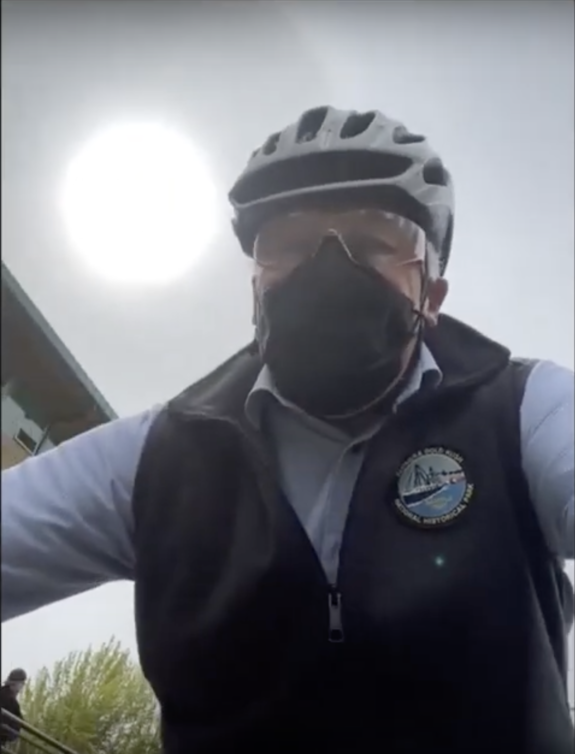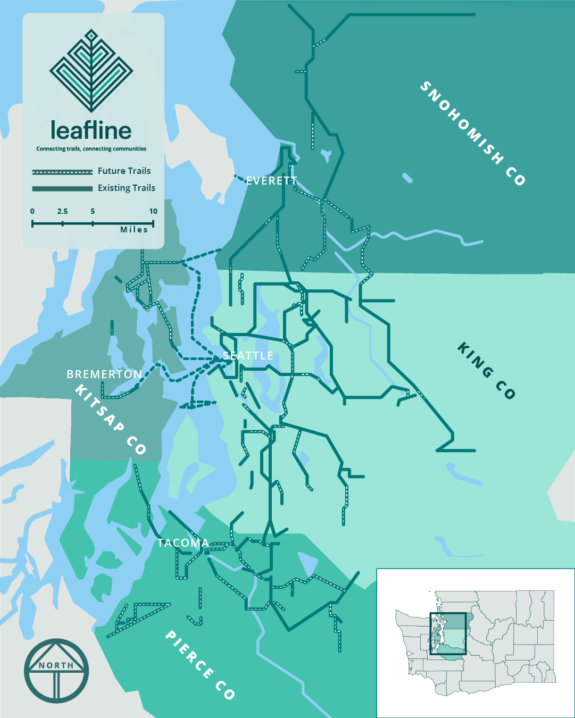
The Leafline Trails Coalition got a special guest for their online event announcing their new 900-mile regional trails vision: Governor Jay Inslee, who called in from a bike on the Sound to Olympics Trail in Kitsap County.
The Governor called in to voice support for the trails vision, which spans King, Kitsap, Pierce and Snohomish Counties. It happens around the 7:00 mark in the video recording of the event. He called it “the most exciting mapping project since Peter Puget mapped the shores of Puget Sound in 1792.”
Of the 900-mile network, 500 miles are already open. So the region is already halfway there.
The Leafline Trails Coalition started in 2019 as a way to encourage and coordinate a trail network that crosses city and county lines. It includes public partners from cities and counties as well as private partners like REI and community organizations. Below is the print version of the map. You can also explore a digital version. You can also see the criteria for inclusion in the map (PDF).
There are about 500 miles of trails today in King, Kitsap, Pierce, and Snohomish counties, but there has never before been a concerted effort to create a network that crosses jurisdictional boundaries and Puget Sound. Currently, 56% of the more-than-900-mile trail network is complete. The remaining 44% includes regional spines for active transportation and outdoor recreation, new links between existing trails, and closes gaps between trails to improve network connectivity.
More than 60 public partners and members have officially pledged support for the vision of Leafline Trails Coalition, joining together to realize an integrated mobility network that allows people to bike, walk, roll, and connect to transit by trail. Leveraging this analysis of the Leafline Trails Network, the Coalition will focus on gap-filling and investment strategy with support from the National Park Service Rivers and Trails Conservation Assistance Program, and pursue wayfinding and signage to improve user experience of the networks.
Recent investments for active transportation from the federal and state governments are at historic highs and will be a key focus of Coalition work with our partners. Many of the signature projects in the Leafline Trails Network are ready now for federal, state, and local infrastructure investments that will stimulate economic growth throughout the region.
Multiple studies have quantified the benefits of regional trail investments in the state:
- Active transportation provides more jobs per dollar than any other type of transportation;
- Trails in Washington provide $5.9 billion in environmental benefits per year;
- Trails cost less to maintain than roads and cause less air and noise pollution;
- Improving access to trails could help close the health gap in Washington;
- Completing a single trail in Pierce County could result in 2.09 million fewer miles traveled by car each year.









Comments
4 responses to “Governor Inslee helps introduce new Leafline Trails vision map while on a bike”
Is there any way to get a comprehensive overview of the planned trails? I know some of these are actively in development but others look like someone just highlighted a rail line or connected two existing segments and said “eh, it would be nice if we could build a trail there some day”. One of the trails in Snohomish County appears to be the very active BNSF line, for example.
(It would also be nice if King County would stop claiming that the Tolt Pipeline Trail is legitimate bike infrastructure but that’s an argument for another day.)
I don’t know if this will ever happen, but if somebody can figure out how to fast-charge an electric bike on a J1772 plug designed for a electric cars, it would be really awesome for long-distance bike trips (once all the trails connect, of course). With quick recharges in places like North Bend and Hyak, you can ride a long way, even with an electric cargo bike hauling camping gear.
To put this into perspective, my RAD bike has a capacity of about 0.66kWh, which means that, at least theoretically, a 6.6kW charging station that takes 8 hours to charge a car has the wattage to charge a bike battery from empty to full in about 6 minutes, which would make recharging a bike battery about as fast as pumping gas. Whether or not this possible without frying the battery, of course, could be a different story.
If your charger supports 220v you could use something like this: https://www.evseadapters.com/products/j1772-ev-adapter-for-ebike/ but it will charge at the same rate you currently get out of a wall outlet. Most chargers are only 2-3 amps, e-bike manufacturers would need to 5x the amps the batteries and chargers can handle to fully utilize a 15 amp wall outlet. I wouldn’t expect electric car charging speeds any time soon… especially since most e-bikes allow you to just swap out the battery.
After 2 years in Pierce county, I am going to whine a bit:
Calling the sidewalk on Schuster parkway a trail is a pretty significant stretch.
Creating a meandering trail far to the north and then back again, instead of just following the river from the port to Puyallup is simply absurd. I am not sure if it’s the railroad or the tribe that’s the obstruction, but if you know tell me. And where we might apply some pressure points to do the obvious would even be more helpful.
If you like breathing and want to continue doing so, don’t go to Lakewood on bike. Ever.